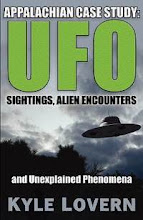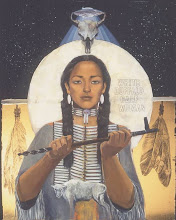Sunday, February 14, 2010
‘Avatar’ also story of deep DNA within many Americans
By Steve Hammons
The blockbuster movie Avatar has triggered interesting discussions and perceptions by a wide range of observers and moviegoers.
However, have we missed some aspects of particularly relevant elements of the film?
There are millions of Americans who carry Native American Indian DNA with them. Yet, many of these people may consider themselves “white,” “black” or “brown.”
Might they also now be going through a transformation similar to some of the characters in Avatar?
James Cameron expands our views of other possibly-inhabited worlds and enhances our perspectives on planet Earth. In the movie, we see a people, the Na’vi, who are similar to Native American Indians.
Three of the main characters, particularly the character Jake Sully (played by Sam Worthington), move their consciousness from their human bodies to hybrid, combined-DNA bodies similar to the Na’vi. As they visit and live with the Na’vi, they come to appreciate and understand this unique culture, and eventually choose to help them defend their land.
Is Jake’s experience of living within a combined-DNA body similar to the many Americans who have mixed-ethnicity backgrounds – especially those with Native American Indians in their family trees?
WIDESPREAD CHEROKEE DNA
An especially relevant example of this situation is the history of the intermingling of Cherokee and early English, Scottish and Scots-Irish trappers, hunters and explorers in the Appalachian Mountain region, primarily during the 1700s.
The Cherokee culture and civilization had thrived for thousands of years in that mountain area that we now call northern Georgia and Alabama, up through North Carolina, Tennessee and the surrounding region.
The matriarchal society of the Cherokee allowed significant independence and freedom for women. And when lonely European men first made their way into Cherokee lands in the early 1700s, Cherokee women were free to develop relationships with them. Nature took its course and babies of mixed ethnicity were born.
As the decades passed, this mixing of ethnic groups present in the Appalachian region continued. By 1800, there were large numbers of mixed-ethnicity people living there.
By the time of the infamous “Trail of Tears” in 1838 – the round-up and forced march to Oklahoma of the remaining Appalachian Cherokee – there were several generations of this mixed-ethnicity population.
Many Cherokee and mixed-ethnicity people had already left the region in previous years. Having seen the writing on the wall, they left their ancestral homeland for places like Arkansas, Missouri, Oklahoma and other areas to the west.
By doing so, they avoided the Trail of Tears, on which approximately 4,000 men, women and children died from hardship, cold, starvation and illness.
Those mixed-ethnicity people who could “pass as white” in the region around the Appalachian Mountains often did so. With Scottish or English names, these people found it wise to self-identify as white due to significant social and legal discrimination against Native American Indians such as the Cherokee.
Over later decades, as many generations of Americans intermarried, this genetic and cultural connection in large numbers of American families became just a family story that no one was quite sure about.
Today, millions of Americans have Cherokee or other Native American Indian DNA within them. Some know it. Some wonder about it. Some suspect it. And many have no idea about this element of themselves and within themselves.
EMERGING CONSCIOUSNESS
Current research in genetics and DNA is making great strides, some people say dangerously so. Much DNA has been mapped and we can identify certain genes which may contribute to physical characteristics or medical conditions.
We can send a sample of a swab from our cheek to DNA testing labs to obtain information about our ancient ancestry.
But there is much about the DNA within us that we do not understand. Much of it is unidentified and its roles are not entirely clear.
Some people wonder what part our DNA plays in our personality, perspectives and consciousness. And, could certain elements of deep DNA, such as ancient Native American Indian genetic background, emerge in our thinking and feeling in some way today?
Like Jake Sully in Avatar, many of us may be experiencing new kinds of viewpoints and feelings about life, Nature and spiritual awareness based on the Cherokee or other tribal DNA and ancient memories within us.
The millions of Americans today who have Cherokee, Native American Indian or other tribal backgrounds within them might be undergoing a transformation. The push and pull within these Americans might be a struggle between different kinds of viewpoints and feelings that have connections to ancient DNA and ancient consciousness.
In some ways, maybe this is also a struggle to not only identify and understand our ancient ancestors within us, but to also experience them here and now in our daily lives and challenges.
As we know, Cameron’s Avatar is not only a fantasy about the future of far-away moon like Pandora or the experiences of the Na’vi people, it is about Earth and the human race today.
Many Americans may be experiencing the confusing and conflicting feelings, challenging decision-making, emerging perspectives and transformation of consciousness that Jake Sully experienced in Avatar.
Sunday, February 7, 2010
ESP in sports: Watch ‘sixth sense’ in Super Bowl
By Steve Hammons
This year’s Super Bowl might show us examples of ESP in sports.
It is well known that constant practice in sports, “situational awareness” and natural athletic gifts can all combine to allow an athlete to perform “on instinct.”
Intense focus in the here and now in the middle of multiple rapidly-occurring events in a sport contest can combine to create an environment where athletes can experience “anomalous cognition,” meaning unusual or unconventional perception and awareness.
Many people have read about ESP in fields like intelligence (US Project STAR GATE), police work and martial arts, but the frequency of anomalous cognition in sports may not be as widely recognized.
What do we mean by the word "instinct?" Some researchers believe that instincts are also related to a “sixth sense” that can transcend our normal view of perception. That is, we can perceive in ways in addition to, complementary to, though different than, our five senses of sight, touch, hearing taste and smell.
Some researchers suspect that ESP and anomalous cognition are not unusual at all. Rather, this is a natural part of human consciousness. It is not paranormal – it is normal. We might even call it “complementary cognition” or “integrative cognition.”
TWO RECON PIONEERS
When the book "Golf in the Kingdom" by Michael Murphy was published in 1972, many people interested in sports had not fully considered the impact of unconventional consciousness in athletics. Murphy's 1992 book "The Future of the Body" also addresses related subjects.
Murphy was co-founder of the Esalen Institute in Big Sur, California, where many elements of the human potential movement and expanded human consciousness were explored. In his younger days, Murphy had served in the US Army as a psychology specialist.
The interests and perspectives of Murphy and many of his colleagues involved in the human potential movement were recently explored in the movie "The Men Who Stare at Goats."
A close associate of Murphy, president emeritus of the Esalen Institute George Leonard, also wrote the 1975 best-selling book related to ESP or expanded consciousness "The Ultimate Athlete."
A fifth-degree black belt in Akido himself, Leonard also explored these topics in the book "The Way of Aikido: Life Lessons from an American Sensei" (1999). Leonard was a former Army Air Corps attack (fighter-bomber) pilot during WWII serving in the southwest Pacific theater. He served as an analytical intelligence officer during the Korean War.
Leonard passed on recently, on Jan. 6, 2010.
STAR GATE AND SPORTS
Perhaps some of the most useful research on the topic of unconventional awareness and perception comes from the US joint-intelligence effort known as Project STAR GATE conducted during the 1970s, ‘80s and ‘90s.
This activity explored the ability of individuals to perceive things, places, information and situations they knew nothing about from a remote location. They were able to gather important intelligence using only their consciousness.
In fact, a Navy SEAL officer wrote in a research paper for the Marine Corps War College that Project STAR GATE reflected a concept he called “transcendent warfare” – using advanced and emerging understanding in new ways regarding defense and intelligence.
Project STAR GATE activities also noted a key element that dovetails with sports and athletics: It seemed that the ESP impressions came to “remote viewers” through their bodies in a somewhat unconscious or subconscious way.
The people involved in the specific technique and protocol named “remote viewing” in Project STAR GATE found that letting impressions bubble up from their subconscious, and not using the conscious mind to try to interpret the information, led to more successful results.
They typically relaxed their minds and used various techniques to attempt to acquire information, then let their body express these perceptions by making sketches and notes in a spontaneous way.
Here we see the connection with sports and other activities. When the task at hand is partially a physical one and we are using our body as much as, or more so, than our conscious thinking mind, we may be more prone to accessing our sixth sense.
In this year’s Super Bowl we might see examples of this if we look closely. And if we open our minds to these possibilities we might see expanded perception in our own lives.
These aspects of human development and education are relevant to not only sports and athletics but a broad range of human activities in many fields.
And what is fun and interesting about the situation is the fact that we can look inside ourselves and explore these fascinating and transcendent elements of human consciousness, tapping into our own sixth sense.
Subscribe to:
Comments (Atom)

























































































































































































